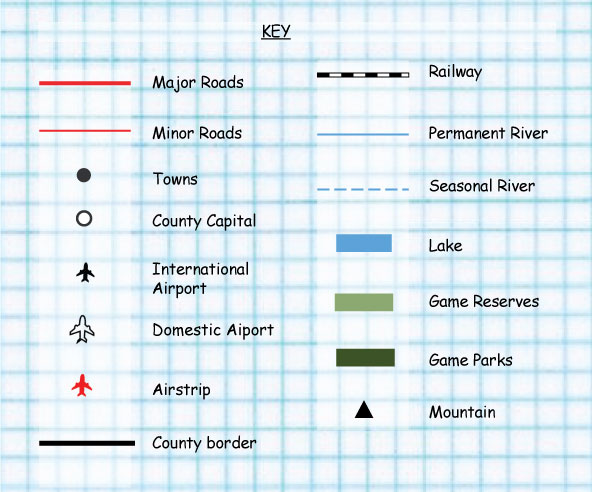Nyamira County
Introduction
Nyamira County is a county in the former Nyanza Province of Kenya.
It was formerly part of Kisii County when Kisii County was a district and is sometimes called North Kisii County. The main cash crops grown are bananas and tea.
The county has a population of 598, 252 (2009 census).
Its capital and largest town is Nyamira, with an urban population of around 41, 668 (2009 census).

Constituencies
- Borabu Constituency
- Kitutu Masaba Constituency
- North Mugirango Constituency
- West Mugirango Constituency
Physical features
Rivers
- Gucha/kuja River which originates from the highlands of Kiabonyoru
- Eaka
- Kijauri
- Kemera
- Charachani
- Gucha
- Bisembe
- Mogonga
- Chirichiro
- Ramacha
- Egesagane
- Sondu
Hills
- Manga hills
- Kemasare
- Kiabonyoru
- Nyabisimba
- Nkoora
- Kemasare
Plains
Importance of physical features
- The hills act as water catchment areas.
- Rivers are a major source of fresh water, which can be used for drinking and irrigation.
Types of natural vegetation
Importance of the vegetation
- Vegetation affects soil development over time, generally contributing to a more productive soil.
- Vegetation provides wildlife habitat and food.
- Vegetation provides direct (e.g., timber) and indirect (e.g., watershed protection) socioeconomic products and services for humans.
- Vegetation gives spiritual and cultural experiences to some people.
- Vegetation can be easily described and mapped, and therefore can be used to:
Map of distribution of physical features.


People and population
Language groups found
Areas of high population density
Social relations and cultural activities
Traditional way of life of the people
Food
- Ugali (a meal made from sorghum and millet), matoke (cooked green bananas), green vegetables and fermented milk.
Dressing
- The traditional dress of the Kisii is made up of banana leaves and cowhides.
Songs and dances
- Traditional Gusii dances were frequent and invigorating affairs, often performed in the evenings after meals, as well as during funerals, wedding ceremonies and at beer-parties for elders, after which the old men and women 'danced vigorously'. Young men of the warrior age group enjoyed war-dances, whilst young women danced to local tunes which they composed and sang, either alone or accompanied by instruments. The Gusii instrument par excellence was the obokano lyre although horns, flutes, gourds and drums were also played.
Traditional medical practices
- Chosen elderly women and men in the community were responsible for treatment as they had the know how than the rest.
- It was an important title to be a medicine man.They used plants which they took a lot of their time to look for in the forest mostly
Ceremonies
It was common to name a child after a deceased person from the father's clan for the first name, and one from the mother's clan for the second name.
Children may also be named for a recent event, such as the weather at the time of the child's birth.
Some common names refer to the time of migrations. For example, the woman's name Kwamboka means "crossing a river."
Initiation ceremonies are performed for both boys and girls, and rituals accompany all important events.
Circumcision of boys at around age of 10 as a rite of passage without anesthesia is common among the kisii.
This ritual takes place annually in the months of November and December followed by a period of seclusion during which the boys are led in different activities by older boys, and is a great time of celebration indeed for families and communities at large.
Festivals
It was done before circumcision. Songs and dances were practiced to mark a successful harvest.
The kisii play a large bass lyre called obokano.
Dance and folks dances were performed after harvest or during naming of a child and also during evenings to educate the young on community morals.
Resources and economic activities
Agriculture
Main cash crops and food crops grown
The areas where the cash crops are grown
- Nyasiongo
- Keroka
- Manga
- Nyamira
Types of livestock kept
- Cattle
- Goats
- Chicken
- Sheep
Fishing
Areas where fishing is practiced
- Nyasiongo
- Sironga in Nyamira.
Forestry
The major forests
- The county has got no gazzeted forest. There are 10 non-gazetted forests covering 256.2ha in the county most of them through reforestation
Wildlife and Tourism
Types of wildlife
- The game parks and reserves
Major tourist attractions
- Koimachingi Falls.
- Keera Falls.
Industries
Traditional industries and the products
Trade
The major trading centers
- Nyamira
- Keroka
- Nyansiongo


